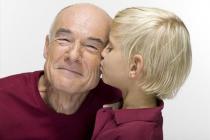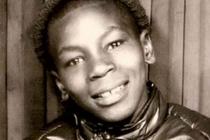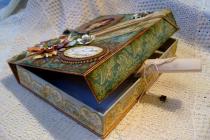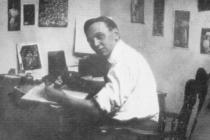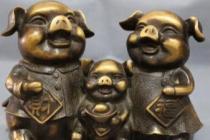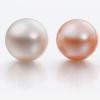Hello colleagues!
There is very little left before the start of the oral English exam. This year it will be on June 15th. I am sure that you are actively training your students now. This year I myself wanted to take the Unified State Exam in English ahead of schedule; I was interested in taking the oral part. But due to family circumstances it was not possible to go. There was too much going on.
Benefits that will delight me for the next school yearIn general, this year I have three students who are taking the Unified State Exam this summer 2017. Now we are actively training tasks from the “Speaking” section. To do this, I am helped by manuals already known to many teachers and tutors.

The photo shows some of the oral teaching aids. Each has its own pros and cons. But despite this, they turned out to be the most used in my work as a private tutor.
This manual is ideal for beginning tutors, because it describes everything in detail, how to work with each task, gives practical examples and exercises, and examines evaluation criteria. There is an audio CD.

The downside for me is the extra 8 pages at the end; they provide a phonetic guide, which I have never used and will never use. I bought the manual mainly because there are 10 practice options and some of them have sample answers. The options are good.
2. English language. Oral part. We are preparing for the Unified State Exam. Author Yuneva S. A. (Buy in Labyrinth)

A big plus of this manual is the huge number (20 pieces!!!) of training options with color pictures on thick paper. As it turned out, color pictures are a very important point in preparation, since looking closely at black and white illustrations and looking at the details is not very good. At the end there are criteria for assessing answers. I didn't find any cons.
3. Unified State Exam. English language. Oral part. Training tests. Author - Milrud R.P. (Buy in Labyrinth, Ozone )

Also a good guide. Contains as many as 160 training exercises to prepare for the oral part. The audio application is downloaded from the website. There are texts to read there. The downside for me is the black and white pictures.
4. English language. Unified State Exam. Oral part. Author - Mishin A. V. (Buy in Labyrinth, Ozone)
A big plus of this manual is a complete analysis of one of the options with step-by-step instructions. I liked the approach, the feeling that an experienced teacher was talking to you, sharing how best to prepare for the Unified State Exam, what phrases to use, why it is better to ask a question this way, and so on. Sample answers to all tasks are given. For these pages alone, the book should be considered valuable for beginning teachers and tutors.

There are five options in total. All tasks where you need to be able to ask a question have answers and how you can ask them. At the end there is a small reference book and typical phrases for describing pictures and comparing photographs. The pictures, unfortunately, are also black and white.
These four manuals were actively used by me in preparation for the oral part. I will continue to work with them next academic year. I don’t think that I can still learn anything new for myself in new books. Now I have a lot of options, there is nothing to save, I need to use what I have.
In addition, I also have a collection that I shared with you in

But two years have passed, the wording has changed a little, and the mistakes that were made have been corrected. In general, I am sharing with you again, but with an updated version. Here are 10 more options for you to add to your collection!
How I work with students' oral responsesBy the way, I once gave you a review of her simulator. So, the book itself turned out to be uninteresting for me, the pictures are difficult to describe and compare. But her simulator turned out to be very useful. Or rather, I only recently realized that you can make options not from her book, but simply include some option from the simulator, and say a completely different option, from the book that you like.
Thus, the time is counting down, like in an exam, and the program makes it possible to record the student’s answer in full.

Why didn't I realize it earlier? It has become very convenient for me; I can write down each student’s answer and then send it by mail. The student listens to his answer again at home and draws conclusions.

It is joyful to notice when each time the student’s answer becomes better and more confident. His voice does not tremble, is clear and loud. As my student said, now there is no shame in listening to yourself.
In general, my advice is to be sure to write down the student’s answer and give them something like a real exam. Microphone and headphones are my constant companions for oral answers. Otherwise, there is no way to psychologically prepare a child if he does not feel like he was in an exam.
You can record on any device: phone, Nemykina’s simulator, Dictaphone. The main thing is that the recording is of a lower quality for listening.
How to deal with the fear of the microphone and recording yourself?My students’ first oral responses were exciting and quiet. There were even small hysterics and breakdowns when it was time to compare pictures, many were lost, because time was passing, the clock was ticking, but they couldn’t figure out the similarities and differences in their heads.
Some of my students were nervous and moved the microphone away with the words: “That’s it. I won't. I do not know anything. I can not. I do not have time". This is a normal reaction. What to do in such cases?

We try to overcome similar situations, where the student is clearly nervous and nervous in front of the microphone, together with the student. How do we usually do it?
- First, the student tries to answer without a microphone. It is necessary to ensure that the student knows the basic phrases and clichés very well and does not waste time thinking about them.
- Then we just talk into an unconnected microphone, we don’t record. Of course, at this stage, I can turn it on if I feel that the child is ready.
- The most important thing is to explain to the student that this is a kind of game, that later he will even enjoy answering, and after the exam he will still say things like: “It’s better to take the oral part again than to sit for three hours on the written part!” There is no need to intimidate the child, but explain in a calm voice why points can be reduced and how best to answer.
- Then we make the first recording.
Usually the student answers quietly. He reads the text quickly, because he is afraid of not being able to complete it in the allotted time. I notice that on the second task the student relaxes a little, since there is plenty of time allotted, and he answers calmly. By the third task, calmness is still maintained by inertia, but on the fourth, when you need to compare pictures, nervousness increases again.
And here is a banal piece of advice - you need to train a lot in order to complete the task within the allotted time and achieve the maximum score.
Now, perhaps, it seems funny to them and not scary at all. But this is the result of hard training. At each lesson, we make sure to set aside time for an oral answer on the record; they know this and are mentally prepared.
I can also recommend the website to help my students, which has a practice version of the oral response recording station so kids can imagine what things will look like on the exam.
This is how, dear colleagues, I work with students and their oral responses. We work together, we survive together. You need to be not only a teacher, but also a bit of a psychologist.
P.S. I was once looking for oral assignments on the Internet and came across some pretty interesting and useful video content. The creator of these wonderful videos is Elena Shramkova. She made them herself. I think it's very cool. Maybe you will like them too, you can let your students watch them.
I hope your preparation for the Unified State Exam is also going well, although, to be honest, I’m already a little tired and want summer. The Kazan spring does not please us with warm days, while it is still cold and windy. And it even snowed today.
Preparing for the Unified State Exam in English requires time and effort. Of course, it is quite difficult to prepare adequately a month before the exam. However, all is not lost! The talented teacher Sofia Vladimirovna shares valuable recommendations and practical advice on what you can accomplish in the remaining time.

The oral part of the exam is the most difficult. Let's look at the most important aspects and common mistakes.
ReadingMany people think that the Reading part is easier than all the others. One cannot but agree that reading skills can be improved in a fairly short time. However, even in this part, year after year, graduates make mistakes that are best not repeated.
What not to do:
1) Replace the diphthong /əu/ with the sound /ɔ/
2) Forget about interdental /ð/
3) Forgetting how to pronounce words
- Enough – [ɪ"nʌf] - enough
- Science - ["saɪəns] - science
- Since - – since then
It is important to remember that the text you read must first of all be well perceived by ear. Pauses, hesitations, repetitions of words, errors in pronunciation and omissions of words make understanding difficult. The result is low scores.
Writing questionsThe next stage is drawing up questions based on the given picture.
1) Remember that questions like What about...? Or I’d like to know are unacceptable, since it is correct to use only direct questions!
Direct questions:
- Do you work on Saturdays?
- When do you open?
Indirect questions:
- I wonder if you work on Saturdays.
- I'd like to know when you open.
2) In most cases, questions must be asked using Present/Future Simple.
3) Don’t forget to change in general questions some - on any , something - on anything , somebody - on anybody .
4) Be careful when asking a special question. Students often add qualifications when adding information to the question that they are asking about.
When did you go to the park in the evening ?
Description of one of the photographsIt is important to follow the plan given in the assignment. This makes it easier and easier to navigate and not miss an important aspect of your story.
1) When describing a photo, use the phrase In the photograph you can see. With the preposition on the photograph - the phrase will be used in a different meaning. For example, don’t put the cup on the photograph .
2) When describing what is happening in the photo, use Present Continuous / Past Continuous. In this case, you cannot use the Simple group tenses.
Comparison of two photos1) Use phrases correctly, paying attention to the article:
If we look at picture 1.
If we look at the first picture.
2) The answer will be more advantageous if the Present Continuous tense + adverbial place or Particle I is used for the first point of the task.
- We can see a girl shopping online at home.
- We can see a girl who is doing her shopping online at home.
3) When talking about similarity, use the word both. It's a mistake to say - the both pictures - No article needed!
4) When talking about your preferences and choosing between two pictures, for example, between two ways of shopping - you should not say - I prefer picture. I must say – I prefer shopping in a supermarket.
Friends, remember one more rule for successfully passing exams - be focused, attentive and believe in your strength! And in order to spend the remaining weeks before the Unified State Exam with maximum benefit, come to classes with online tutors at our school.
website, when copying material in full or in part, a link to the source is required.
Update. Please note that this article was written in 2015 and has not been updated or expanded since then.
I would like to collect in one article everything that I know today about the format of the oral part of the Unified State Exam in English, as well as about the exam evaluation criteria. Everything stated below is based on information posted on the website of the Federal Institute of Pedagogical Measurements, as well as presentations and reports given by Macmillan, especially those made by Maria Valerievna Verbitskaya, the author of numerous textbooks on the English language, one of the leading experts on the Unified State Exam. I tried to be as accurate and attentive as possible when presenting the facts. If you believe that any information in this article is inaccurate or outdated, please write about it in the comments.
 First, a small announcement. Demo versions of the exam and the entire package of documents (specifiers, codifiers, demo versions) for the exam are located on the new website at http://new.fipi.ru. (the old site is operational, a bank of open tasks is posted there).
First, a small announcement. Demo versions of the exam and the entire package of documents (specifiers, codifiers, demo versions) for the exam are located on the new website at http://new.fipi.ru. (the old site is operational, a bank of open tasks is posted there).
They wanted to return the oral part of the Unified State Exam in a foreign language for quite some time. The only problem was how to do this in an accessible and methodologically sound form. At the experimental stage, in 2004-2008, there was an oral part, but then they decided to exclude it. Mainly due to organizational difficulties, such as time restrictions (the exam is long, students are very tired), poor technical equipment and an insufficient number of experts.
When introducing speaking in the 2014-2015 school year, we decided to take the path computerization, that is, they refused the participation of a “live” examiner (only a technical specialist will be in the audience), students “communicate” with the computer, a digital recording of the answers is kept, which will be assessed by experts after the end of the exam. Over time, they want to computerize the entire exam.
The oral part is conducted on a separate day, after a few days break.
Maximum the number of points for the oral part is 20. For the written part - 80 points.
The oral part is not (!) compulsory, but it will need to be taken by those who want to get more than 80 points for the exam.
The minimum score is currently 22, previously it was 20. The threshold is very low, 99% of students overcome it.
When developing the exam, the compilers faced a huge number of scientific and methodological difficulties regarding the exam format, difficulty levels and assessment criteria. This year, the oral part of the Unified State Exam in English will consist of the following tasks.
1. Expressive reading of a fragment of informational or popular science text out loud.
Example.
"C3. Imagine that you are preparing a project with your friend.You have found some interesting material for the presentation and you want to read this text to your friend. You have one minute to read the text silently, then be ready to read it out aloud.
You don't see many birds in winter. Most have left your area. Those that stay are not as active. Activity uses energy that is needed to keep warm. The worst problems for birds in winter are getting enough heat and holding on to the heat once it is made. These are problems for all birds."
Setting the base level, score - 1 point.
Students are required to read clearly and expressively, which is easily perceived by ear without any interruptions in communication.
Main evaluation criteria:
- speech is easy to understand
- there are no unnecessary pauses,
- phrasal stress, intonation contour and pronunciation of words without violating the norm,
- The emphasis in the words is placed correctly.
Allowed no more than 5 phonetic errors(including 1-2 errors that distort the meaning), that is, even if a student makes 5 phonetic errors, he will still receive 1 point. A score of 0 points is given if speech is difficult to perceive (a large number of unnatural pauses, hesitations, incorrect emphasis, more than 5 phonetic errors, more than 3 errors that distort the meaning).
2. Conditional dialogue-questioning with verbal and visual support.
"C4. Study the advertisement.
You decided to visit the place and now you are calling to make some clarifications. In a minute you are to ask five questions to find out the following:
1) dates for departures
2) hotel facilities
3) if breakfast is included
4) number of city tours
5) availability of party reductions"

Necessary ask 5 direct questions (of any type) using key keywords, which are in the task.
Setting the baseline. Behind every question - 1 point. Total maximum 5 points.
The content of the question must correspond to the task, that is, it is necessary to ask about what needs to be asked, and have the correct grammatical form of a direct question. Evaluated linguistic and intonation design. Intonation should correspond to the type of direct question being asked; possible phonetic and lexical errors should not impede perception.
Grade 0 points is displayed if the question is not asked, if the content of the question is incorrect, if the question is not grammatically formulated, or there are lexical and phonetic errors that impede communication.
There may be some debate about the types of questions. So far the compilers have decided so. A dividing question is possible, requests from the series What about...? Could you tell me about...? do not count as questions, since they are essentially requests. Questions like Could you tell me what the price is? is not considered incorrect if the word order is correct.
One of common mistakes- instead of asking questions, students begin a story based on the picture. In this case, a score of 0 points is given, since the communicative task has not been solved.
3. Monologue thematic statement based on the verbal situation and visual information.
Example.
"C5. Imagine that while traveling during your holidays you took some photos.
Choose one photo to present to your friend. You have one minute to think it over.
When presenting the picture remember to mention:
when you took the photo
what/who is in the photo
what is happening
why did you take the photo
why you decided to show the picture to your friend

Setting the baseline. Must be described only one photo. During testing, a problem arose with this. The children did not read the assignment, or read it inattentively, and began to describe all three photographs. In theory, there shouldn’t be such a problem during the exam, since the student will need to press one of three buttons, and only one picture will remain on the screen.
Next, I will highlight the whole sentence in bold, since this point was not obvious to me. To get a high grade, you need a coherent story consisting of 12-15 sentences, with an average of 3 sentences per paragraph. If a student says only one sentence for each item, then he will not receive a high score for this task.
Are being assessed three criteria:
- solving a communication problem (3 points).
3 points are awarded if the communicative task is completed in full, the content fully, accurately and comprehensively reflects all aspects specified in the task. 2 points - if one aspect (point of the plan, what is in detail) is not disclosed, 1 point - if two aspects are not disclosed (or all aspects are disclosed, but very little is said). 0 points - if the task was ignored, or three or more aspects were not disclosed.
- Organization of oral presentation (maximum 2 points).
This is where I don’t really agree with the requirements, namely the need to say introductory and concluding phrases, for example, “I"d like to show this photo/ That"s one of the most beautiful photos ... or That"s all I wanted to say ... But... demands are demands.
- Linguistic design of the statement (maximum 2 points).
Language design is a complex and rather subjective criterion; the difference in the approaches of experts is of great importance here. Since the speech is spontaneous (1 minute to prepare is very little), errors and reservations are allowed. The main thing is that there are no language errors that impede communication. Total maximum 7 points.
I'll highlight one more sentence because it's important. A common mistake made by students is that children say that they are the ones captured in the photo, although the assignment simulates a situation where they cannot be in the photo, since they took the photo. In case of such an error, 0 points are given for the task, since the student did not complete the communicative task and did not understand the task.
4. Monologue thematic task.
"C6. Study the two photographs. In a minute be ready to ...
1) give a brief description of the photos (action, location)
2) say in what way the pictures are different
3) say which of the pastimes presented in the pictures you prefer
4) explain your choice

This task is fundamentally different from task 3, as it is a high-level task. This requires analytics and a fairly high other level of language training, since a basic level of vocabulary and grammar will not be enough. Evaluation criteria - see point 3. Total maximum 7 points.
A few more points. Preparation time for each task is about 1.5 minutes. The answer time for the first 2 questions is 1.5 minutes, for the second 2 questions - 2 minutes. Total time to complete the oral part of the exam is 15 minutes. Students are NOT expected to take any rough notes during the exam as very little time is given for preparation. In January, Macmillan will release a new collection of tests for preparing for the Unified State Exam.
The exam compilers recommend the following as basic aids for preparing for the Unified State Exam:
 |
Task 3. Imagine that while traveling during your holidays you took some photos. Choose one photo to present to your friend.
- when
- what/who
- what
- why
I"ve chosen photo number...
Approximate answer (photo No. 1):
I"ve chosen photo number 1.
- I took this photo last summer when I went to London during my holidays.
- In the foreground of this photo you can see the London Eye which is the largest observation wheel in Europe. It is located on the south bank of the river Thames. There are two motor boats on the river. In the background you can see some modern buildings.
- As you can see the day is dull and glowy and the sky is gray with clouds. It looks like it"s going to rain what is very typical for London. But nevertheless there are always a lot of people waiting for a ride on this popular attraction. There are 32 (thirty-two) capsules on the wheel which are rotating very slowly. Ech capsule contains 25 (twenty-five) people.
- I took this photo because it is a well-known landmark of London. From the very top of the London Eye we had a stunning view of this magnificent city. We saw the river Thames, the Houses of Parliament with its famous Big Ben, Westminster Abbey and other sites.
- As my friend has never been to London, I decided to show him this picture and to share all my impressions of this terrific flight with him.
That's all I wanted to say.
Approximate answer (photo No. 3):
I"ve chosen photo number 3. (Be sure to start your answer with this phrase, having first chosen the photo number.)
- It is very lovely, isn't it? I took this photo last summer when I went to Moscow to visit my relatives. It was my first trip to the capital of our country and I wanted to see as many historical places as possible.
- In the background of this picture you can see the Cathedral of St. Basil the Blessed. Its tremendous houses struck my imagination. It "s unbelievable but none of them is like the others. Each dome has its own shape and color. Once I have read a legend that Ivan the Terrible blinded the architects Barma and Postnik because he didn"t want them to create another masterpiece. There is a lot of greenery in the courtyard of the Cathedral. In front of the Cathedral there is a monument to Minin and Pozharsky.
- The Cathedral and the monument are located in Red Square. There are always a lot of tourists from different countries who want to visit these places. But now you cannot see any visitors because it was early morning.
- I took this photo because these sights are famous landmarks of Moscow.
- As my friend is fond of history and often makes reports for history classes, I think, he can use this picture for his school project.
That"s all I wanted to say. (End your answer with this phrase, which will signal the end of communication.)
Approximate answer (photo No. 2):
I"ve chosen photo number 2. (Be sure to start your answer with this phrase, having previously chosen the photo number).
After studying the sample answers, describe photo No. 2 yourself.
As you can see from the above answers, you will need not only language knowledge, but possibly also life experience. If this does not turn out to be the case, which is unlikely, use your knowledge from other subjects, for example, history, geography, literature or art.
So, to summarize:
1) The time to complete this task is very limited - 1.5 minutes to prepare and 2 minutes to answer. You will NOT have the opportunity to make any notes or notes during preparation. Hence the conclusion - it is extremely useful to memorize the necessary clichés for fluency:
- In the picture you can see…
- On the left / on the right of the picture…
- In the foreground of the picture... (in the foreground)
- In the background of the picture... (in the background)
- In the middle of the picture... (in the middle)
- At the top of the picture… (above)
- At the bottom of the picture… (below)
- Next to (next to)
- Behind (behind)
- Near (about)
- Under
- In front of (before)
The appropriate revolutions would be There is.../There are... I would like to draw your attention to the fact that after the revolution in units. In numbers, you need to use the indefinite article “a” before countable nouns.
e. g. There is a ticket office near the Eiffel Tower.
2) When answering the plan question “when you took the photo,” use Past Simple Tense. Remember that you were a photographer, and therefore (well, of course, if it’s not a selfie) you need to describe the people in your photo (relatives, friends, acquaintances or strangers), and not your loved one.
e. g. I took this photo two months ago when I went to Paris to study French.
3) Stick to the given topic of the statement. To do this, please read the assignment carefully. For example: Imagine that you are preparing a presentation about London (Russia) or Imagine that you are preparing a school newspaper about Art.
4) When answering the question “what/who is in the photo”, try to describe not only the person’s appearance, but also, presumably, his mood (sad - sad, happy - happy, serious - serious, angry - angry). Pay attention to the weather conditions in the photo (sunny - sunny, hot - hot, warm - warm, cloudy - gloomy, rainy - rainy, cold - cold, frosty - frosty day). Name the time of year (month) when you took the photo.
5) As you can see the question What is happening in the picture? is in the Present Progressive Tense, so when describing the events taking place in the photograph, also use verbs in the present continuous tense, supporting your answer with the phrase At this particular moment... (at this particular moment...). You can also continue your story in Past Simple Tense.
6) Think through several possible answers to the question “why did you take this photo”: I took this photo to remember the best moments and places of my journey. / I think this picture will remind me about my new foreign friends I met during my visit to Scotland (Italy, Egypt etc) and wonderful days we spent together.
7) Remember, your description should not be too detailed, because you may not meet the time allotted for your answer. As you prepare, write down your answers and then speak them out using a timer. In this way, you will develop a sense of the time that you need to answer task 3 of the oral part of the Unified State Exam in English.
You will have to start speaking in 1.5 minutes and will speak not more than 2 minutes.
In your talk remember to speak about:
- when you took the photo (when you took the photo)
- what/who is in the photo (who/what is in the photo)
- what is happening (what is happening in the photo)
- why you took photo (why did you take this photo)
- why you decided to show the picture to your friend (why did you decide to show this photo to your friend)
You have to talk continuously, starting with:
I"ve chosen photo number...
Sample answer (photo No. 1)
I"ve chosen photo number 1.
(Be sure to start your answer with this phrase, after selecting the photo number).
- I took this photo in one of the beautiful parks in Edinburgh when I was on my trip to Scotland two years ago. It is quite amazing, isn't it?
- In the foreground of the photo you can see two girlfriends spending their free time hanging around. They might study or work together. They seem to be in a good mood. They both are wearing all Scottish style suits, but the girl on the right who"s got blond hair is wearing a yellow tartan, while the girl on the left has got a black-and-white pattern. Moreover, she"s got an incredible hat which perfectly matches the rest of her clothing. The most stunning thing that caught my eye was her hair done in dreadlocks. In her right hand she is holding a black handbag made of leather.
- In the background of the picture there are a lot of green trees with bushy (thick) crown. It was early September and it happened to be a very warm and sunny day. But nevertheless some people put on their jackets because the weather is very changeable and unpredictable on the British Isles. The man on the right who is wearing a checked shirt might be a tourist because he has got a blue backpack. As you can see at this particular moment the place is not overcrowded, so I think, it is great to enjoy your leisure time with your nearest and dearest in such a place.
- I asked the girls to take their picture because I liked the style they were dressed up and I decided to show it to you because you are also keen on wearing unusual and freakish hats and maybe, the picture will give you some new ideas.
- That is all I wanted to say
Sample answer (photo no. 2):
I"ve chosen photo number 2.
(Be sure to start your answer with this phrase, after selecting the photo number).
- I took this photo during my winter holidays when we went to the ski resort in the Caucasus. After the Winter Olympic Games 2014, Sochi attracts lots of tourists both from Russia and from around the world.
- you can see two children: a boy and a girl. They came here from Novosibirsk. They told me that they had started to ski when they were only three years old, that"s why they look very confident on the snowy mountain slopes. The children are wearing bright ski suits made of special fabrics that protect them from cold and at the same time are very light that helps them move quickly. They also have all the necessary skiing equipment for this kind of sport such as alpine skis, plastic boots with special bindings, helmets, ski poles and goggle mounts.
- you can see mountain peaks covered with snow and some kind of pines. You can"t see the mountains quite well from behind the clouds but it is a common phenomenon in this area.
- At the very particular moment the children are learning a new downhill technique. And now they stopped for a while to take breath. Sometimes I saw them landing in a fall but they went to square one again and again. They didn't give up, so I should admit that they have got strong willpower. As you can see they look very healthy and happy. I believe that it"s very useful to take up to sport from childhood. This will teach you to overcome difficulties in life, will teach you to win or to lose.
- I took this photo because we made friends with the family from Novosibirsk and their cute kids and I want to remember the beautiful moments of my vacation.
- I decided to show you this photo because I want you to appreciate these two young sportsmen and the beauty of the Caucasus Mountains.
- That is all I wanted to say. (a mandatory phrase for the examiner indicating the completion of communication)
Sample answer (photo no. 3)
photo 3
I"ve chosen photo number 3.
(Be sure to start your answer with this phrase, after selecting the photo number).
- I took this photo in London Zoo when I was on my trip to the UK a year ago. To tell the truth, I’m not very good at photography but this picture turned out to be a beautiful one.
- In the foreground of the picture you can see a colony of pelicans. You can’t but agree with me that pelicans are large birds with very long beaks. They have a long neck and short stout legs with webbed feet. The tail is short and square. They have pale plumage with some gray feathers on the wings.
- On the left of the picture there is a pond where the birds can swim. The zoo keeper told us a lot of interesting things about pelicans. She explained to us that some species could make their nests in the trees while the others nest on the ground. It was interesting to know that they can fly but cannot dive because of their light skeleton. I also learned that pelicans live up to 25 years in the wild and up to 40 years in captivity. But the most amazing fact is that pelicans never store their food in their throat pouch contrary to popular folklore. They use it for catching fish.
- In the background of the picture you can see a girl taking photos. At this particular moment the birds are cleaning their feathers after being fed. Guess what! We were allowed to give them some fish and it was really exciting! All in all the weather was warmish and I had a great time there.
- I took this birds photo because I had never seen those before in real life and wanted to remember all places I had visited in London.
- I decided to show you this photo because you are interested in photography and have got a big collection of snapshots of birds. I think, it would be great if you could add my picture to it.
- That's all I wanted to say. (a mandatory phrase for the examiner indicating the completion of communication)
The main mistakes that students make when completing this task:
- description of three pictures instead of one;
- incorrect interpretation of the content of the picture;
- lack of expression of one’s opinion about the plot of the picture;
- absence of colloquial clichés when describing a picture;
Task 4 is a monologue comparing two photographs or pictures.
To successfully complete this task, you need to adhere to the proposed plan:
- give a brief description of the photographs (what is happening in the picture, the location of the action)
- tell me what these photographs have in common (what theme unites them)
- tell me how these photos differ
- express your preference using one of the photos
- explain why the theme of the selected photo is close to you
Preparation time - 1.5 minutes
Duration of your answer - 2 minutes
Maximum score - 7 points
The following tips will help you write a logical description of photographs or pictures:
When describing a room or house, use the technique from right to left or from left to right (so called “walking tour of the house”);
When describing photographs or paintings, use the technique from left to right, right to left, from edges to center, from foreground to background;
When describing a person, use top-down or bottom-up techniques.
Task4 Variant 1
- explain why
Start your answer with an introductory phrase:
I would like to compare and contrast these two photos. / I would like to point out right at the beginning that there are different ways of going in for sports. And these two photos prove that.
I should say that the common theme of these pictures is doing sports. / I think the common thing here is ... / I believe that the theme which relates these photos is ... / One thing that picture 1 and picture 2 have in common is ...
Sample answer:
Let me start with the first picture which shows a little girl who is in the gym at the moment. The girl is going to play table tennis because she is carrying a red tennis racket in her hand. As we can see the gym is well equipped. In the middle of the gym there is a big blue table with a tennis net on it. In the background of the picture you can see some sports facilities such as flying rings, a gymstick, a rope, a hoop and others. All in all, it seems to me that the gym is quite large and light.
As for the second picture it shows a young man running in the field. It might be summer time because he is wearing a green t-shirt, black shorts and white sports shoes. Also, he is wearing a watch on his wrist for timing his heats. Though the sky is blue and the weather is warm and sunny you can see two mountain peaks covered with snow in the background of the picture.
As I"ve already mentioned both pictures are connected with doing sports. You can"t but agree with me that both - a girl and a young man look fit and healthy.
Obviously, we can see certain (some) differences. The first picture shows a little girl whose hobby is playing tennis. On the contrary, the man in the second picture is a professional sportsman as he looks very sporty and strong. Besides, the first picture shows the girl who is playing tennis indoors while the young man is going in for sports in the open air. Moreover, table tennis is a team game and you need at least one more person to play it with. As to the track-and-field athletics, you can do it on your own.
As for me, I"d prefer to take up to table tennis because I am fond of doing sports with my best friends or relatives. Secondly, this game develops quick thinking and reaction. Finally, you can do it outdoors as well as indoors and bad weather cannot spoil the pleasure.
In conclusion, I would like to say that both pictures make me think that sport is a great way to spend your free time and, of course, it is useful for your health.
That"s all I wanted to say. Thank you for listening. / That"s where I"d like to end. (final phrase)
There were 25 phrases in total. It is necessary to construct your answer so as to fit within the time allotted for the answer (2 minutes). Recommended number of phrases: 12 -15, but no less. Remember that opening and closing sentences are judged by experts; their absence will negatively impact your grade.
Task 4 Variant 2
Study the photographs. In 1.5 minutes be ready to compare and contrast the photographs:
- give a brief description of the photos (action, location)
- say what the pictures have in common
- say in what way the pictures are different
- say which kind of the activities presented in the pictures you"d prefer
- explain why
Start your answer with an introductory phrase:
I would like to point out right at the beginning that I will compare and contrast these pictures.
I believe that the theme which relates these photos is a life style of the youth.
Let me start with the first picture that shows a group of young people who are at work now. The man on the right and a young woman in a black suit are sitting around the table while the woman in a beautiful white suit is standing at the moment. Unfortunately, I can’t see the face of their boss who is giving them some instructions. They are listening to him very attentively. It looks as if they are ready to make some notes because you can see pads (notebooks) in front of them.
As for the second picture I have the impression that the group of young people is enjoying their free time sitting on the grass. I can only guess that they might be co-students at the international language school because you can see them carrying their workbooks. They are probably having their break time now. As the weather is warm and sunny, they decided to spend it in the school yard. They all are smiling and look very happy so I think they did their test successfully.
I should say that the only similarity between picture 1 and picture 2 is that they depict young people who are practically of the same age.
One of the main differences between pictures is that in the left picture you can see two men and two women (four people) working in the office, whereas in the right picture there are two girls and a boy who are having a rest in the open air. The most obvious difference for me between these two pictures is people’s clothes. For example, people in the first picture are wearing suits according to the dress code of their firm, while people in the right picture are wearing casual clothes such as jeans, jumpers and trainers.
As for me, I would rather go to a language school because my dream is to speak English fluently. Moreover, it would be interesting to make some new friends from abroad.
To sum it up, I would like to say that to work or to study together with smart and intelligent people is always a great pleasure.
(final phrase)
Task 4 Variant 3Study the photographs. In 1.5 minutes be ready to compare and contrast the photographs:
- give a brief description of the photos (action, location)
- say what the pictures have in common
- say in what way the pictures are different
- say which kind of the activities presented in the pictures you"d prefer
- explain why
Start your answer with an introductory phrase:
I would like to compare and contrast these two photos.
I think the common thing here is classical music.
Photo 1
Let me start with the first picture which shows a young girl who is performing on the stage at the moment. She is wearing a white blouse and a dark skirt. She is playing the grand piano together with a string orchestra. In the background of the picture there is a beautiful organ. In the foreground of the picture you can see a lot of spectators. That’s why I can say that music is not just her hobby but she is involved in it very seriously.
As for the second picture it also shows a young girl playing the piano. She looks very elegant in her black velvet dress. As you can see she is wearing glasses. In the background of the picture you can see a portrait of a famous composer. Unfortunately I’m not very good at classical music that’s why I don’t know his name. Under the portrait there is a basket of lovely roses, so I can only guess that it might be the anniversary of the composer.
As I have already mentioned the theme which relates both pictures is classical music. The most obvious similarity between photo 1 and photo 2 is the musical instrument the girls are playing and it is a piano. It is evident that the girls are practically of the same age. In my opinion, they might be very talented.
You can't but agree with me that the main difference between picture 1 and picture 2 is that the girl in the first picture is performing in a big concert hall whereas the girl in the second picture is playing the piano in a small room.( It is probably the classroom in a local Art School.) Besides, the girls are wearing different items of clothes. Last but not least , in the first picture you can see a lot of audience while in the second picture we cannot see any listeners.
As for me, I would rather go to a big concert hall because I’ve always wanted to listen to the organ.
Summarizing, I may say that it is great to have a good ear for music and play a musical instrument because music always makes your life brighter. (23)
That's where I'd like to end. (final phrase)
Task 4 from the section Speaking on the Unified State Exam 2015 in English, use the following expressions:
Firstly - firstly
Secondly - secondly
Thirdly - thirdly
Moreover - moreover
It seams to me / It looks like / It might be - It seems to me / It should be
I can only guess - I can guess
If I"m not mistaken - If I’m not mistaken...
I"m not sure exactly (what this is) but ... - I’m not sure exactly what it is, but ...
As for me / To my mind / In my opinion / I think / I believe / Personally - As for me / In my opinion / I think / I am sure / Personally I...
In contrast / Unlike ... - In contrast
The most apparent/obvious difference (similarity) between photo 1 and photo 2 is ... - The most obvious difference (similarity) between photo 1 and photo 2 ...
The main difference/similarity between picture 1 and picture 2 is ... - The main difference/similarity between photo 1 and photo 2 ...
The only difference/similarity is ... - The only difference/similarity...
To sum it up I would like to say that... - To sum it up, I want to say...
All in all, it "s evident ... - In general, obviously ...
Summarizing, I may say that... - Summarizing, we can say that...
The main mistakes that students make while completing task 4:
- describing the plot of two pictures, rather than comparing them;
- lack of highlighting common and distinctive characteristics of pictures;
- lack of expression of attitude towards the pictures;
- lack of introductory and closing phrases;
- absence of colloquial clichés when comparing pictures;
- phonetic and lexico-grammatical errors in the answer.
Study the advertisement.
You are considering joining the Yoga Club
1)address of the club
2) opening days
3) if they offer classes for the aged people or for the young
4) fee per week
5) morning training programs
Tips for completing the task:
To successfully complete this task, you need to repeat the topic of constructing questions in English: all the details
The question must correspond to the task at hand.
The question should be pronounced with an intonation appropriate to the type of question being asked, for example, rising in general questions and falling in specific questions.
You can ask all five questions of the same type (for example, Special questions); this will not affect your score.
Sample answer:
After a trial exam in the oral part of the Unified State Exam in English, it became obvious that it was not possible to start a conditional dialogue-question with the phrases below!!!
Each of the five task points will appear on the computer screen in turn. You will have only 20 seconds to construct a DIRECT QUESTION, so, without being distracted, proceed to the task.
1) What is the address of the yoga club?/ Where is the club located?
2) What are the opening days?/ What days is the club open?/ When is the club open?
3) Do you offer classes for the aged people or for the young only?
4) How much is the training program per week?/ What is the training fee per week?
5) You have got morning training programs, haven't you? / Are there any morning training programs? / Have you got any morning programs?
Task 2
Study the advertisement.
You have 20 seconds to ask each question.
You have decided to celebrate your birthday in the restaurant and now you are calling to find out more information. In 1.5 minutes you are to ask five direct questions to find out the following:
1) availability of table for 10 people for Sunday afternoon
2) if booking is free
3) kinds of meat dishes on the menu
4) variety of dessert they serve
5) place to dance
Sample answer:
1) Is a table for 10 people available for Sunday afternoon? / Can I book a table for 10 people for Sunday afternoon?
2) Is booking free? / Should I pay for reservation? / Is booking free or should I pay for reservation? / Booking is free, isn't it?
3) What meat dishes do you have on the menu in your restaurant?
4) What do you serve for dessert? / What desserts do you serve?
5) Where can we dance? / Is there any place to dance? / Do you have any place to dance? / You"ve got some place to dance, haven"t you?
Task 2
Study the advertisement.
You have 20 seconds to ask each question.
You are going to visit the fashion show and now you are calling to find out more information. In 1.5 minutes you are to ask five direct questions to find out the following:
1) how to get there
2) if you can book tickets on-line
3) price of the tickets
4) information about the clothes
5) opportunity to buy any items of clothing
Sample answer:
1) How can I get to the college?
2) Can I book tickets on your website?/ Can I book tickets on-line? / Is there any possibility to book tickets on-line? / Are the tickets available online?
3) What is the price of the tickets? / How much are the tickets? / How much do the tickets cost? / The price of the tickets is not very high, isn’t it? / The tickets are not very expensive, are they?
4) Where can I find information about the clothes on the show? / Is there any information about the clothes on your website? / I can find some information about the clothes on your website, can"t I?
5) Will I have the opportunity to buy any items of clothing after the show?
Introductory words are taken into account when assigning points. In C5 there should be 4 of them and not necessarily intricate ones, while in C6 there should be 5-6
View document contents“Unified State Examination in English Speaking Speech clichés”
When completing tasks of the oral part C5 and C6, be sure to use introductory and connecting words to connect sentences. The transition from one point of the plan to another should be smooth and logical.
Introductory words are taken into account when assigning points. In C5 there should be 4 of them and not necessarily intricate ones, while in C6 there should be 5-6
Treat your computer like an interlocutor
| Task C5. Plan for describing the picture. (photo description) : |
||
| Plan item | Translation |
|
| Well, I have chosen to show you photo number 2. | ||
| When and where you took the photo | Look! I’d like to show you this amazing / awesome / gorgeous / terrific / unusual / stunning / spectacular / disappointing picture. I took it while traveling/ when I was on holiday with my friends / parents / classmates last … We were visiting / trekking / going to … then. I took this photo because I was so impressed by the scene that I wanted to capture that moment forever. Moreover, it was the most unforgettable part of our trip. Besides, it was one of the most stunning / disappointing moments in our trip. | Listen! I would like to show you this amazing/cool/unbeatable/amazing/unusual/stunning/spectacular/disappointing photo. I made it when I was with friends/parents/classmates on vacation in the past... We visited/crossed/walked….. I took this photo because I was so impressed by the scenery that I wanted to capture that moment forever. Moreover, it was the most unforgettable part of our trip. It was also one of the most wonderful/disappointing moments of our trip. |
| Who/What is in the photo | To start with, the picture shows/depicts…You can see…in the picture. In the background, there is/are…. In the foreground, we can see…. There is... in the picture. On the right / left there are (is) ... In the right / left hand corner… In the foreground/ background, there is… There are... in the foreground / background. In the bottom part of the picture there is… There are… in the top part of the picture. The people in the picture are… The people in the picture look happy because… The people in the picture seem sad because… The general atmosphere in the picture is positive because…. The picture was taken in… The weather in the picture is… The atmosphere in the picture is depressing because… Speculating about the situation | Let me start with the fact that the photograph shows/displays...In the photo you can see...In the background,... In the foreground we can see…. I would say... In the photo there is... Right left …. In the right/left corner... In the foreground/background... …. in the foreground/background. At the bottom of the photo... …. at the top of the photo. People in the photo... The people in the picture look happy because... The people in the photo seem sad because... The general atmosphere of the photo is positive, because The photo was taken/taken... Weather in the photo... The atmosphere in the photo is dull because... Reflecting on the situation... This could be... |
| What is happening | The person/people in the picture is/are…They probably will… It seems to me that... They could be... It's probably... Imagine they're... Another idea is that... It is also possible that… It’s not clear if... It seems to me that the people in the picture… I get the impression that the people are not very happy here… They don’t seem to be enjoying themselves… | The person/people in the photo...They are probably... I think that… They could... Maybe… Probably,… Imagine that they Another thought is that... It is also possible that... Dont clear……. whether…. It seems to me that the people in the photo... I got the impression that the people in the photo are not very happy... They don't seem to be enjoying themselves... |
| Why did you take the photo | What I meant by taking this picture is that I wanted to catch/save this unforgettable moment from my life. What's more... I liked the landscape so much that I decided to capture/to save it. It was a great experience in my life. They were the friendliest / the most helpful / hospitable people in our journey and I liked them so much that I decided to take a picture of them. | What I meant when I took this photo is that I wanted to capture/preserve this unforgettable moment from my life. Moreover… Besides,… I liked the landscape so much that I decided to capture/save it. It was a great experience in my life. They were the friendliest/most helpful/most hospitable people on our trip and I liked them so much that I decided to photograph them. |
| Why did you decide to show it to your friend | I decided to show this picture to you, because…This is a good chance for you to get the first impression of… Looking at it from your perspective, you would… I decided to show this photo to you as I’d like to share my emotions / feelings / impressions with you. Also, I want you to know more about… | I decided to show this photo to you because... This is a good opportunity for you to get a first impression of... In my opinion, you would... I also wanted to know more about... |
| Conclusion | That’s all I wanted to tell you about this picture. | That's all I wanted to tell you about this photo. |
Task C6. Comparing and contrasting two photographs using introductory and connecting words (comparing / contrasting):
| Plan item | Translating to Russian language |
|||||||||||||||||||||||||||||||||||
| introduction | Introduction on the topic of the picture (e.g. jobs, eating out, fast food, environmental problems, etc.) | This is a photo... and this is a photo.... |
||||||||||||||||||||||||||||||||||
| a brief description of the photos |
|
|
||||||||||||||||||||||||||||||||||
| similarities |
| |||||||||||||||||||||||||||||||||||
| differences |
|
|
||||||||||||||||||||||||||||||||||
| your opinion |
|
|
||||||||||||||||||||||||||||||||||
| conclusion |

